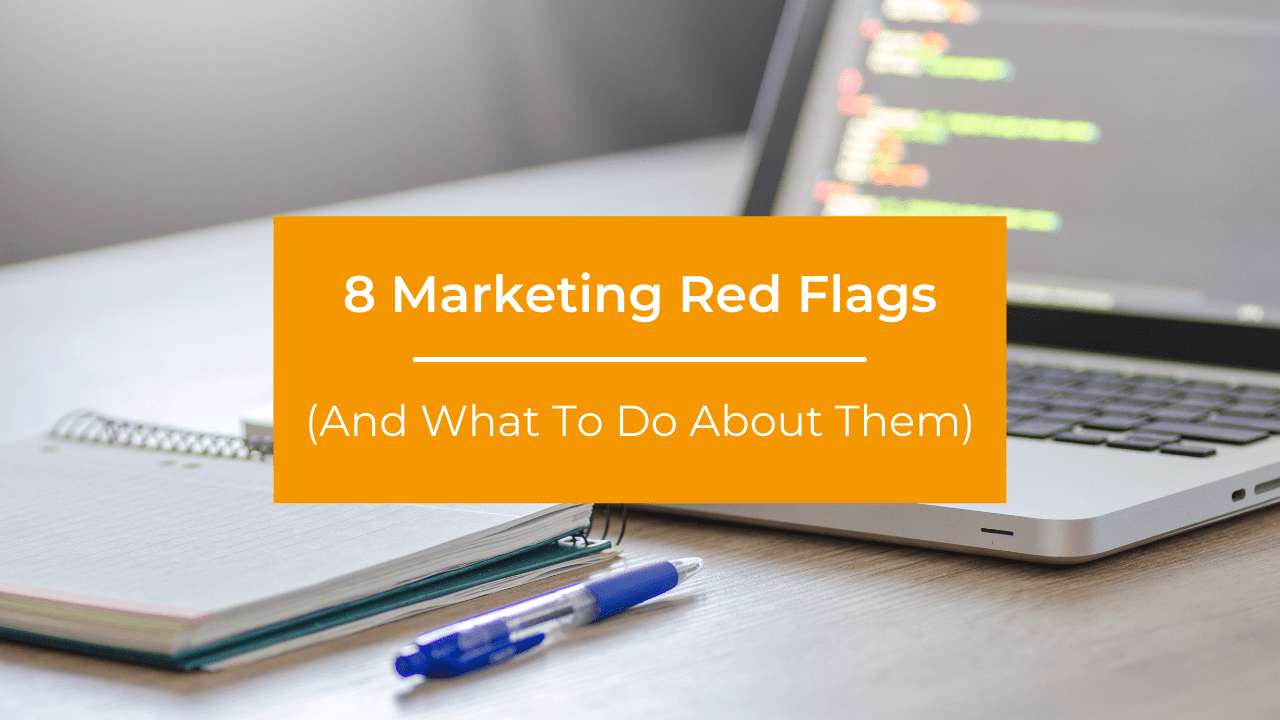You’ve probably heard the term ‘red flag’ being batted around in polite conversation, scrawled across memes on Instagram, or even in the headlines of articles like this one. Initially used across sports to convey danger, the term is having a bit of a resurgence at the hands of the millennials and Gen Z-ers, who have repurposed it, in a half-mocking way, to describe unsavoury characteristics in potential dates.
Whether it’s someone holding a fish in their Tinder profile picture, or an overly enthusiastic hug on the first date, these red flags tell us that maybe we’re not on the same page. But like most good internet trends, the phrase is taking off and being used across mainstream media.
We’ve been asking our clients and networks what marketing red flags they see from colleagues, clients and agencies. If you’ve come across or are guilty of any of them, we’re not going to leave you “on read”, we’re going to tell you what they might mean and what to do next.
🚩 #1 – Reactive decision making before we have enough data to lead the decision making
Why this is a red flag:
Being reactive in marketing whenever something seemingly slips out of the green and into the red, can be hugely detrimental to long-term strategy. With more and more marketing methods relying on automation and machine learning, changing variables too early, we may harm the algorithm’s ability to learn from the data we provide and diminish the long-term results of the campaign.
What this red flag is indicative of:
There is more pressure to produce results in a shorter time frame.
What we suggest instead:
Take a wider view of the campaign and the original strategy and timelines that the current plan of action is working towards. It’s important to be clear that we’re making a change for the right reasons based on feedback in the way of data.
Also, what comes after this decision if nothing changes? Are there any ramifications to later stages in the marketing strategy or customer journey? Often we see brand awareness ads turned off to release budget for lead generation ads, which often generates more leads in the short term at the expense of long-term market position.

🚩 #2 – Checking your own ads/keywords relentlessly
Why this is a red flag:
This shows a lack of trust on the agency and strategy. We know that businesses live and breathe their industry, and it is important to stay on top of what is working and what is not, but clicking, viewing, or repeatedly searching for your ads skews your KPIs on reports and ultimately costs you!
What this red flag is indicative of:
Trust issues after being burnt by agencies before and looking for the first sign that something may not be working.
What we suggest instead:
If you want to succeed with Google Ads, you need to review and refine your account’s performance regularly. In particular, you’ll want to monitor the status and progress of both your ads and their keywords. We see it all the time, where clients want to turn off certain ads or keywords because they didn’t convert as well during a week.
Some weeks are good, and others are unpredictable. We often suggest paid ads as a short-mid term strategy to get quick results whilst an investment in SEO builds your intent-based traffic in the background. It takes time for the algorithms to learn and it’s wise to let things play out before making any sudden changes. Using careful planning and extensive research gives us the best idea of what will work well.
Finally, what you see and your prospects see are different. Google reacts to user intent and if you regularly search for your business without clicking the ads you will stop being shown the ad. It’s better to utilise your reporting and analytics for these insights.
🚩 #3 – Trying to “go viral”
Why this is a red flag:
‘Going viral’ is little more than a buzzword most of the time. There is no set plan or strategy when it comes to going viral, and there isn’t a clear structured procedure in place for doing so. Most of the time, people who ‘go viral’ just happen to tap into the collective conscience of the public at the right time, and it’s more of a coincidence than a measured approach.
What this red flag is indicative of:
Wanting to achieve brand awareness without spending money on ads.
What we suggest instead:
The internet is a catalyst when it comes to viral trends content. ‘Going viral’ is the strategy of mimicking popular content that appears to have garnered success for several other entities, fueled by viral trends and internet culture.
Experimenting with a small budget for paid Google ads or paid social media will give you a good idea of what results you are likely to get with an advertising campaign. Pinning your hopes on trying to ‘go viral’ is unwise as it is a very unpredictable strategy and more often than not will leave you with no results.
🚩 #4 – Intrusive pop-ups on websites
Why this is a red flag:
They are just plain annoying! Imagine you’re in a restaurant browsing a menu and the waiter starts throwing coupons at you or asking where you last went on holiday before you’ve gotten to the end of your order.
The concept is the same, unwanted and unexpected intrusions that can ruin the entire experience for someone.
What this red flag is indicative of:
You want to capture leads and encourage them to take action.
What we suggest instead:
There’s a fine line between design principles and marketing results, and pop-ups are one of those on the border. Despite breaking nearly every user experience best practice, pop-ups remain one of the most popular methods of generating leads from traffic online.
Intrusive pop-ups can be super annoying for users and can block the content they are trying to see. They force users to take action, which is fine if they convert, but only exaggerates it if they don’t. They can also harm SEO as Google has moved to penalise websites with pop-ups that are intrusive to the user experience.
It is important to review the value that the pop-up is adding to your marketing efforts. If you are generating high-quality leads by using them, then it may be worth the compromises.

🚩 #5 – Not looking after current customers
Why this is a red flag:
Imagine you’re in that same restaurant, and instead of the waiter hovering around and being irritating, your date for the night is rude to the staff. This is a red flag as it shows us a clear lack of humility and gives you reason to believe they might one day treat you the same.
When you abandon your customers once they have converted, it harms your lifetime value and can damage your reputation.
What this red flag is indicative of:
Focusing on generating leads and new sales so much that the people at the earlier stages of the customer experience get ignored.
What we suggest instead:
Customer retention is cheaper than customer acquisition. Understanding your audience and the journey they take to become a customer is really important to consider for your marketing strategy. Because audiences can vary so widely based on industry and intent, persona research is really important.
According to HubSpot, 67% of customers would pay more to get a better customer service experience. This shows customer service is an important factor to customers, so much so that they would pay more to interact with a business that does it well.
🚩 #6 – Advertising – Wanting to reduce advertising costs without seeing leads decrease
Why this is a red flag:
Costs and results are generally tied together in a messy scramble net of knots, so trying to detach them often leads to a tug of war that neither side can win.
What this red flag is indicative of:
Decision-makers are looking for ways to reduce business costs, and marketing is always the first area to cut.
What we suggest instead:
It’s an understandable and often sensible reaction to cashflow issues to reduce the advertising. However, it should be balanced against the damage this can do to future cash flow if the investment is reduced for a lead-generating campaign.
Plus there’s no guarantee that what is working now will work again if the ads are turned on again in the future.
🚩 #7 – Everything that comes after “I was chatting to a friend and….”
Why this is a red flag:
‘Asking for a friend’ is a classic way to try and table an idea, without taking responsibility for its formation. While we’re happy to listen and take on board different approaches, more often than not these titbits of ‘helpful advice’ come from unqualified professionals.
It’s a bit like going to the doctor’s and telling them what you found on WebMD, instead of listening to their experienced and earned insight into your problem.
What this red flag is indicative of:
Someone they trust has offered a piece of wisdom that contradicts the current approach.
What we suggest instead:
Qualify the experience and skillset of the source of that information above their relationship. As a scientist would, marketers should welcome challenges to their approach. Challenges often make the strategy more robust. Marketing is an area whereby an opinion can be given as much consideration as well researched best practice for that audience.
🚩 #8 – Looking for free advice on GDPR
Why this is a red flag:
While this is something marketers need to be concerned with, GDPR compliance should be a combined effort between the business, marketers, and specialist GDPR lawyers.
What this red flag is indicative of:
This is a fair request, GDPR often concerns itself with cookies and data tracking and so marketers should know a lot about that.
What we suggest instead:
The penalty for getting this wrong is severe and to avoid being sued, most sensible marketers will caveat any advice they offer with “we’re not legal experts”.
Get the information from a specialised GDPR lawyer and not someone who has watched a webinar on it.



